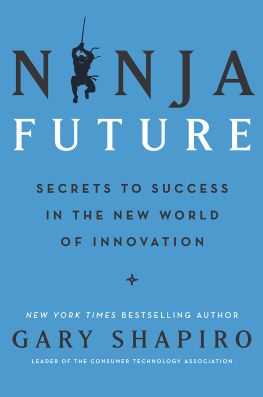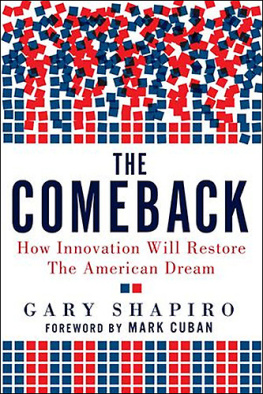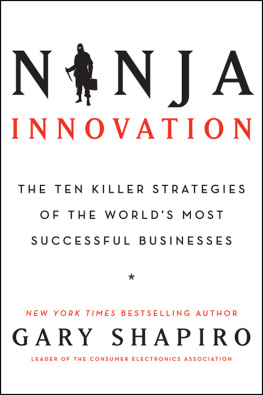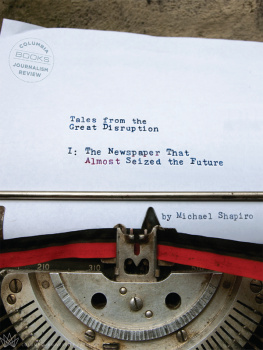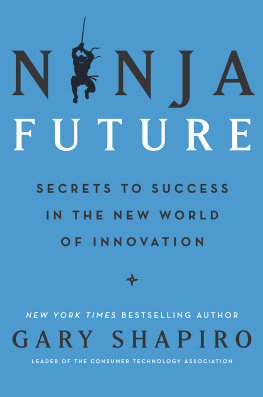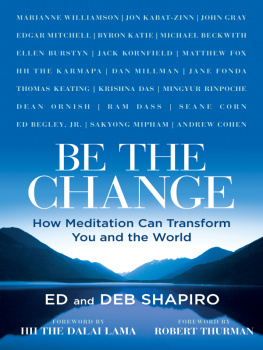Table of Contents
Landmarks
A BOOK IS RARELY A solo performance. This one was a beautiful ninja orchestra with a magnificent conductor and fabulous instrumentalists!
While I conceived and wrote most of my first two books, this one was different. Beginning in 2017, Rachel Horn, a CTA communications director, suggested repeatedly that I write another book. I often responded that I had several ideas that were good, but no ideas that were great. She broke through my reluctance, stating she had reviewed scores of commentaries I had written since my last book and saw a consistent big idea of a better future thanks to the innovation we knew was coming.
In early 2018, we released CTAs first International Innovation Scorecarda ranking of more than thirty countries by how innovation-friendly they are. This was a pet project of mine, but it provoked valuable internal discussions on what it takes for a nation to be innovative. This is a question I often get from national political leaders as I travel the globe speaking about innovation. After a lot of hard work, CTAs 2018 International Innovation Scorecard succeeded beyond our expectations and is an important set of guideposts underlying much of this book.
Our CTA Scorecard team agreed on key parameters. We debated and eventually agreed on not only the criteria and their measurements, but also our fundamental commitment to transparency, honesty, and the ability to take input and keep improving the product over time. Headed by another great communications pro, Izzy Santa, the project benefited from the quantitative analysis of Jack Cutts, the communications sagacity of Tyler Suiters, the research skills of Angela Titone, the promotion prowess of Bronwyn Flores, and the policy expertise of Walter Alcorneach of whom also helped develop and review content for this bookand the organization of Johanna OKeefe.
With the Scorecard as a backdrop, Rachel and I agreed on a book aimed at government leaders and business executives, as well as those interested in understanding the many changesand challengeswe know are coming. Rachel offered to craft an outline with the concepts from my commentaries and move the process forward. Once she delivered an outline and brief first draft, I was inspired to add to its depth and interest by adding the values expressed in the global scorecard along with real-life stories, advice, and experience.
HarperCollins, the publisher of my last book, was excited about the idea of sharing my updated perspective on how ninja innovators will embrace our digital future. I appreciate the enthusiasm of HarperCollins, and in particular Nick Amphlett, for the topic, as well as their support for this project and belief in my voice and value.
The editor of my last two books was not available, so Rachel recruited and worked closely with a fabulous book editor, Shannon Last. Although Shannon, Rachel, and I never sat down all together in person, through the innovation of Google Docs we organized the structure and turned several different sections into (hopefully) interesting and cohesive prose.
Along the way, we received substantive input from many other members of the CTA team, including Curtis Kincaid (manuscript review); Katherine Rutkowski and Eriq Ocampo (general research); Caitlin Cline (citations); Sage Chandler, Doug Johnson, Julie Kearney, Jamie Boone, Michael Hayes, Katie Reilly, Nathan Trail, and Maya Sharma (all on various policy content); Jennifer Taylor and Jacqueline Black (workforce content); Loren Wray (HR content); Dave Wilson and Mike Bergman (technology expertise); Steve Koenig, Ben Arnold, and Lesley Rohrbaugh (industry trends content); and John T. Kelley, Allison Fried, and Sasha Spellman (CES-related content).
I could not have completed the book without the daily support from several people on the CTA executive team:
Chief Operating Officer and Chief Financial Officer Glenda MacMullin heads the team who beautifully manages so many aspects of CTA, sparing me time and concern.
Executive Vice President of CES Karen Chupka and her team ensure CES and other CTA events gather and inspire innovators and innovation.
Senior Vice Presidents Michael Petricone (government and regulatory affairs) and Tiffany Moore (political and industry affairs) and their teams not only push for pro-innovation policies and a workforce trained for the future, but are always advocating for and raising the interests of the groups who can and should gain from innovation: small businesses, entrepreneurs, creators, traditionally underrepresented groups, and the less fortunate.
Senior Vice President Brian Markwalter (research and standards) sets an example for his skilled and dedicated team, one thats committed to delivering high-quality market insights and making consumers technology experiences easier and more efficient.
I am also grateful to Senior Vice President Jean Foster (marketing and communications) and her lieutenants Tyler Suiters, Michael Brown, and Sean Perkins, who eagerly took on this project, even though it was outside their expertise. I must also acknowledge their work built on that of our former marketing head Susan Littleton, who touched so many of us before her untimely passing in 2018.
I want to thank John J. Kelly, Kara Maser, and Gaby Chavez for getting through legal issues. I also want to thank my scheduler Tyler Stenberg for not only making this book a priority in my schedule, but also transcribing many of my hard-copy edits to our shared online document. Tyler, Kailey Adametz (who runs my office), and Jacqueline Black (who until recently ran my office) are true ninjas who always break down brick walls to make things happen.
I am so proud that these and our other CTA employees are so effective, dedicated, relentless, and creative in pursuing our cause of innovation. They inspire me with their resourcefulness, passion, and belief that technology and innovation can provide a better world. It is our sacred mission to ensure the events, government policies, and information and technology environment is right to help us realize our best future.
This book could not have proceeded without the blessing and support of the CTA Executive Board: Chairman David Hagan, Vice Chairmen Mike Dunn and Steve Tiffen, Industry Executive Advisor Pat Lavelle, past chairman Daniel Pidgeon, and board members Mike Fasulo, Randy Fry, Bridget Karlin, Jim Mault, Laura Orvidas, Eliott Peck, John Penney, Joe Stinziano, and Fred Towns. Also, a big dose of gratitude goes to ex officio board member John Shalam, whose grace, dignity, generosity, and wisdom to CTA and me have made him my mentor and father figure. This is one ninja board which focuses on the big picture, is willing to take a stand, and is always principled and passionate about the cause of innovation.
Additionally, I appreciate the work of the Pinkston Group. David Fousea longtime partner of CTALauren Carl, Nancy Ritter, and Julia Smith helped frame my thoughts and bring this book to life. Their strategic approach in helping develop and promote my public voice served as the basis for many parts of this book.
The work CTA does for innovation is supported by so many worthy groups. The Center for Democracy and Technology ensures privacy and innovation can coexist. The Media Institute protects our freedom of speech. Third Way and No Labels are bipartisan groups proposing innovative solutions to real problems. Other trade groups and think tanks, including BSA | The Software Alliance, CompTIA, the Computer & Communications Industry Association, CTIA, Information Technology Industry Council, Internet Association, Northern Virginia Technology Council, R Street Institute, Software & Information Industry Association, TechNet, and the Technology CEO Council, work hard with government to ensure innovation can flourish. And events including CEDIA, Collision, InfoComm, Mobile World Congress, NAB Show, South by Southwest, and Unbound facilitate entrepreneurs and innovation.

